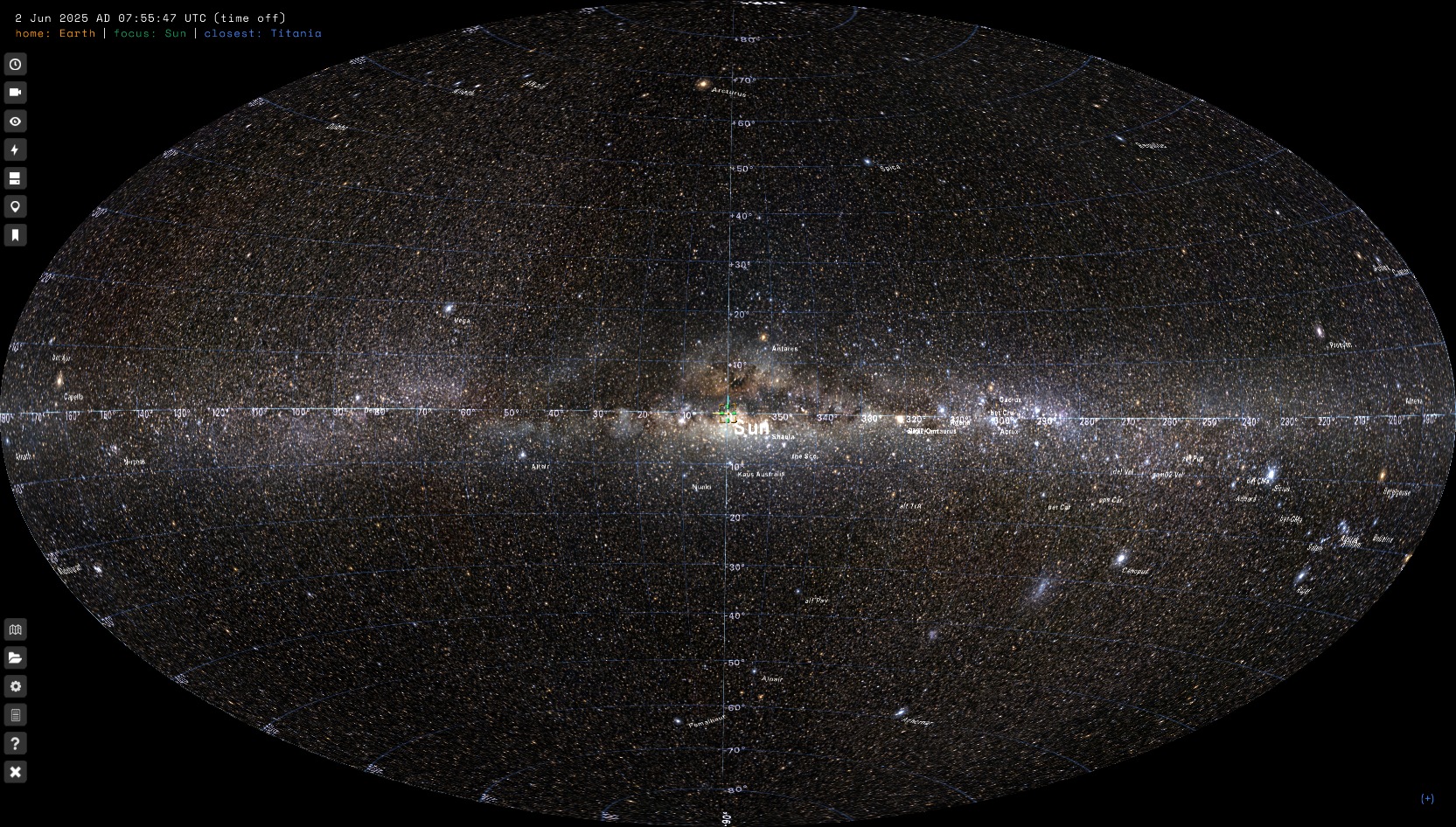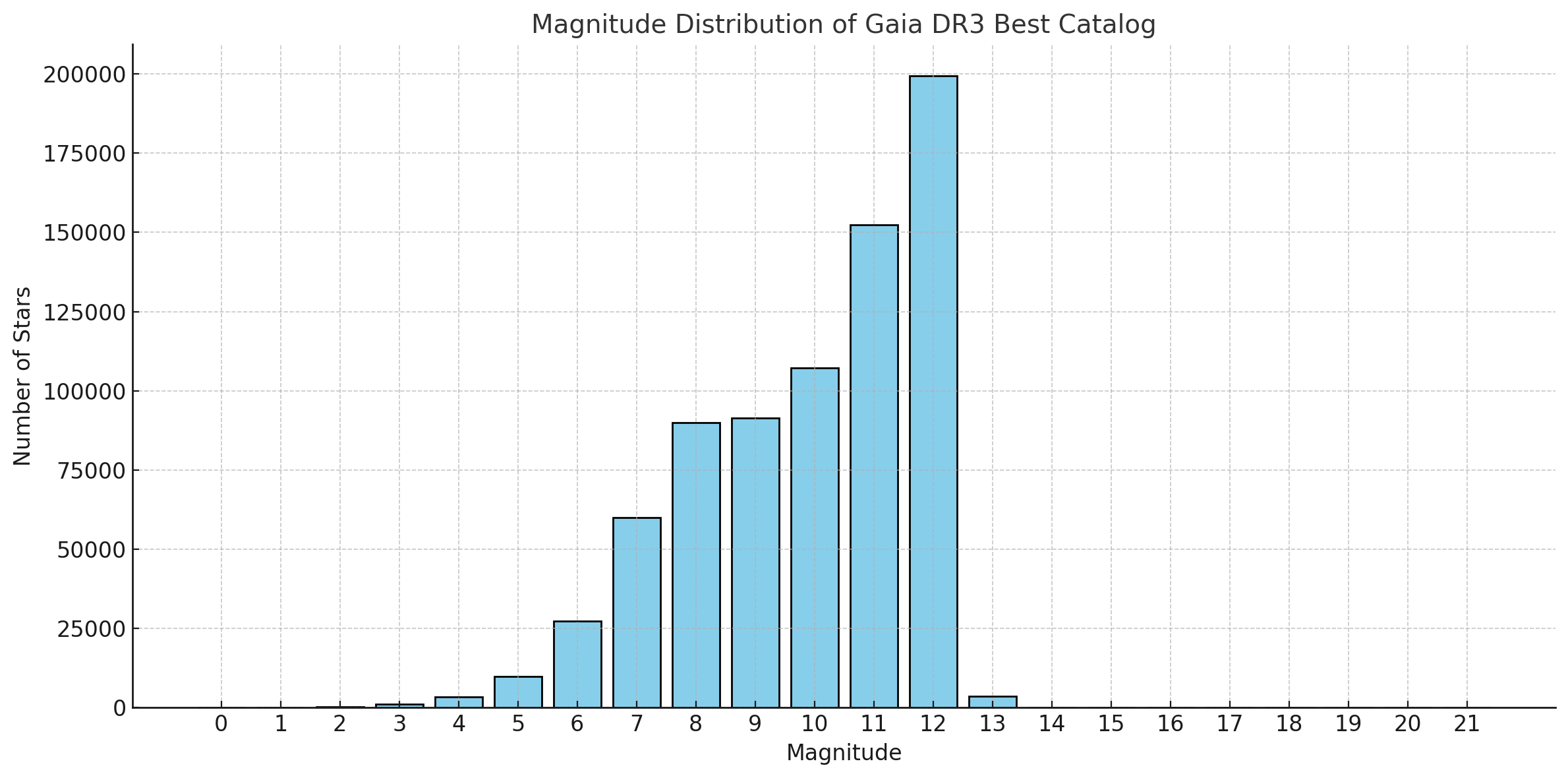New Catalog: Gaia DR3 Best
By tsagrista on
Today we make available a brand new catalog in Gaia Sky, derived from the Gaia Data Release 3 (DR3) dataset. This catalog is a handpicked collection of the most precise stellar measurements available in DR3, designed for applications where accuracy in parallax and astrometric fidelity is essential. This catalog includes a total of 646,400 stars, with a clear bias toward brighter magnitudes. It is a small, non-LOD (non-Level-of-Detail) catalog, designed for broad compatibility. It will be the recommended star dataset starting from Gaia Sky 3.6.8.
It is ideal for:
- Laptops
- VR
- Low-end desktops
- Devices without dedicated GPUs in general
- Use cases where performance and simplicity matter more than completeness

Hammer projection of the new Gaia DR3 Best catalog.
What does it include?
The Gaia DR3 Best catalog includes:
- 646,400 stars, carefully selected from the 1.8+ billion in Gaia DR3.
- All stars with relative parallax error ≤ 0.4% for bright stars (
gMag< 13.1). - All stars with relative parallax error ≤ 0.002% for faint stars (
gMag>= 13.1). - The full set of Hipparcos stars, cross-matched and merged into the dataset.
This makes it ideal for high-precision visualization, distance estimation, nearby star studies, or any work requiring only the cleanest subset of the Gaia DR3 catalog.
Why another Gaia catalog?
Gaia DR3 is a treasure trove, but not all stars are created equal when it comes to measurement quality. This dataset is suitable for low-end devices, and distills the most trustworthy data from the full release, eliminating sources with:
- Negative or low-quality parallaxes
- Non-finite magnitudes
- Poor astrometric solutions
Here’s a breakdown of how we got from 1.8 billion stars to 646k:
| Step | Count |
|---|---|
| Initial Gaia DR3 entries | 1,811,709,771 |
| Rejected due to parallax (criteria + negatives) | 1,805,626,704 |
| Rejected due to non-finite magnitude | 5,455,190 |
| Final stars selected | 646,400 |
This dataset loads fast, uses less memory, and is visually cleaner in 3D than the full Gaia DR3 catalog.
Magnitude distribution
The stars span a wide range of magnitudes, with the majority in the range 8 to 12. Here’s the magnitude histogram:

Magnitude distribution of Gaia DR3 Best catalog.
Click for raw data
| Magnitude | Count | Percentage |
|---|---|---|
| 0 | 20 | 0.003% |
| 1 | 49 | 0.007% |
| 2 | 257 | 0.034% |
| 3 | 994 | 0.133% |
| 4 | 3,347 | 0.449% |
| 5 | 9,839 | 1.319% |
| 6 | 27,198 | 3.647% |
| 7 | 60,012 | 8.046% |
| 8 | 90,040 | 12.072% |
| 9 | 91,461 | 12.263% |
| 10 | 107,119 | 14.362% |
| 11 | 152,413 | 20.435% |
| 12 | 199,507 | 26.750% |
| 13 | 3,546 | 0.475% |
| 14 | 5 | 0.001% |
| 15 | 2 | 0.000% |
| 16 | 3 | 0.000% |
| 17 | 11 | 0.001% |
| 18 | 4 | 0.001% |
| 19 | 3 | 0.000% |
| 20 | 1 | 0.000% |
| 21 | 1 | 0.000% |
As expected, the catalog skews toward brighter stars with more accurate parallaxes.
Technical notes
- Catalog size: ~54.5 MB
- Epoch: J2016
- Format: Gaia Sky binary octree
- Tree depth: 1 (single octant for all stars)
- Max distance: 100,000 parsecs
You can find the dataset under the key gaia-dr3-best in the Gaia Sky catalog selector. The full path in disk is:
$data/catalog-gaia-dr3-best
Direct download: Gaia DR3 Best Catalog
Use cases
This catalog is especially suited for:
- Running Gaia Sky on lower-end machines without sacrificing precision
- Creating interactive educational content
- Building realistic local universe models
- Studying nearby star neighborhoods